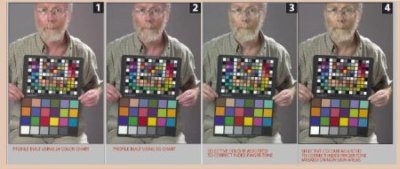articles/Printing/accurateskintone-page5
The Accurate Reproduction Of Skin Tones - part 5 of 1 2 3 4 5 6 7 8
by Mike McNamee Published 01/06/2005

Pink Babies and Red Grandads!
Now for the tricky bit. In spite of our best endeavours we still find under certain situations that flesh tones do not come through accurately, even under controlled conditions. Given that you have shot RAW, click balanced for the colour temperature of your lights and then adjusted your exposure in the RAW processor against your Macbeth Chart you might be forgiven for thinking all would be well. Fat chance! Most experienced digital photographers will tell you that if they shoot a wedding party, some people will be standing out like beacons in the crowd. Your editor should know he is one of them!
After some deliberation and searching through literally hundreds of medical research journals we are starting to get some pointers. There are two potential sources for the increase in redness. The colour of the skin is determined by the melanin concentration, its colour and also the proximity of the blood vessels carrying oxyhaemoglobin, the red oxygenated type. These blood vessels are buried under the outer layers of the skin and the penetration of light through this layer and back out again influences the colour appearance. The colour balance of the skin has been described as Tan versus Rosiness. Given that only red heads (aka your editor) have the red melanin (pheomelanin) it seems a reasonable hypothesis that they will turn up more red under stronger illumination. There is a further hypothesis which, to date we have not tested. Detectors in digital cameras are more sensitive to infrared light and to overcome this and prevent excess reds in the final image, a "hot" filter is often employed to shield the near infrared light (NIR). If this effect is balanced for the majority of scenes it seems reasonable that under some conditions, extra NIR might get back to the camera.

Regardless of the underlying reasons for the effect, the evidence is easy to collect. In the 4-up image shown, your editor is excessively red in images [1] and [2]. In image [3] the overall red balance has been adjusted using selective colour on the reds with a hue adjustment of +9 on the reds. However this has dragged the Macbeth light skin swatch too yellow - it is not responding to the camera in the same way at all. This is the classic selective red effect. To overcome it the mask of the Colour Adjustment Layer has been painted, to control where the colour adjustments are active [4].
In order to provide more background data we took the opportunity to photograph and measure the two young ladies featured in the picture above. We measured the skin specta of each girl and determined the Lab values on the forearms, fingers and the back of their hands. We are unsure of the accuracy of the technique but the two skin complexions were different in the way you would expect, with a rotation towards yellow for Emily (on the left). In the image file, which was corrected using a bespoke camera profile, Sally, on the right had hue angles of between 6° and 24° whilst Emily had angles between 24° and 27°. Both girls are relatively pale skinnned with saturation values of 15% for Sally and and 25% for Emily. This difference is just obvious in the original image and should survive through the magazine printing process.
Please Note:
There is more than one page for this Article.
You are currently on page 5
- The Accurate Reproduction Of Skin Tones page 1
- The Accurate Reproduction Of Skin Tones page 2
- The Accurate Reproduction Of Skin Tones page 3
- The Accurate Reproduction Of Skin Tones page 4
- The Accurate Reproduction Of Skin Tones page 5
- The Accurate Reproduction Of Skin Tones page 6
- The Accurate Reproduction Of Skin Tones page 7
- The Accurate Reproduction Of Skin Tones page 8
1st Published 01/06/2005
last update 09/12/2022 14:50:46
More Printing Articles
There are 26 days to get ready for The Society of Photographers Convention and Trade Show at The Novotel London West, Hammersmith ...
which starts on Wednesday 14th January 2026





